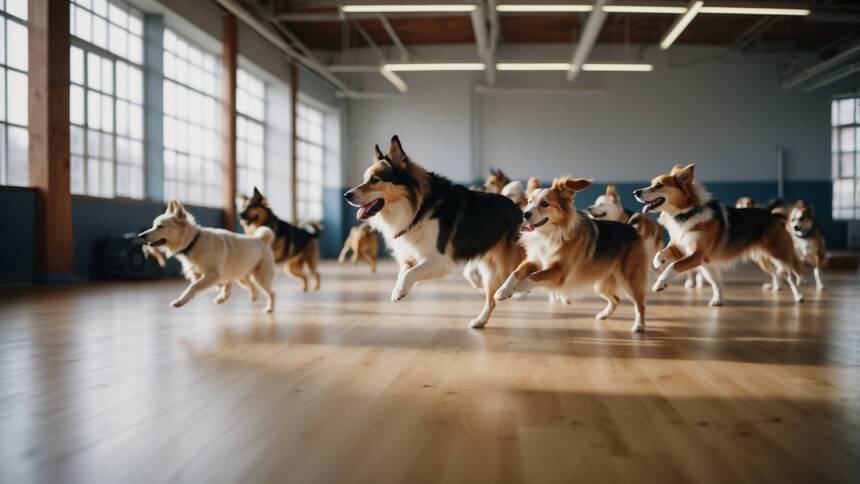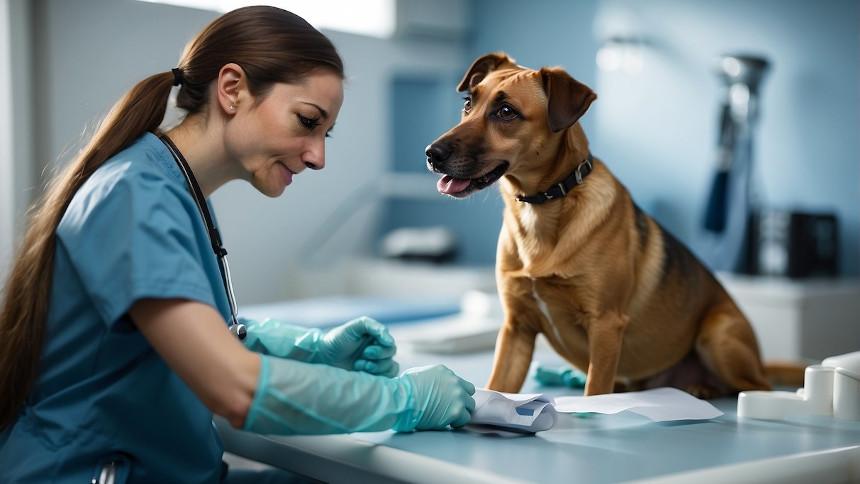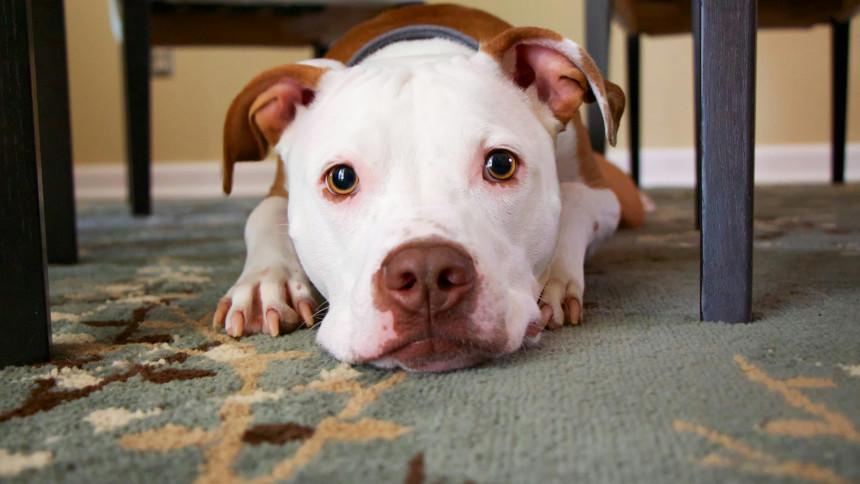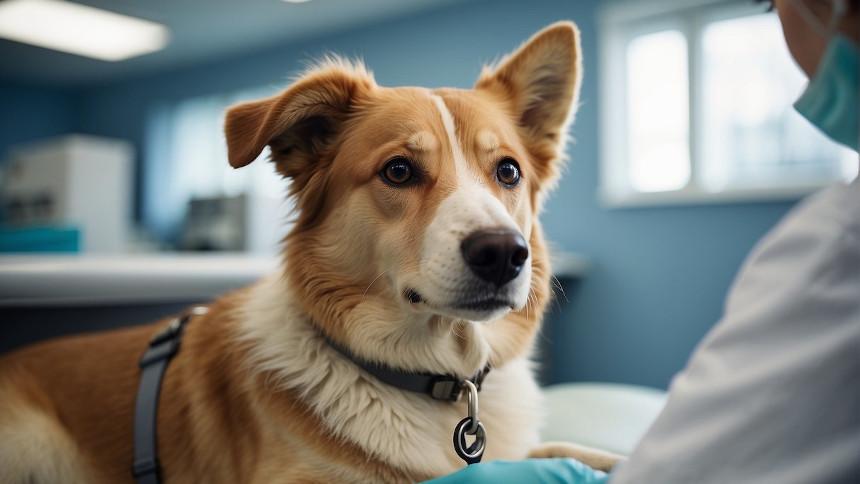Dog aerobics is an engaging way to improve the physical health and well-being of dogs through structured exercise routines. Much like in human fitness, maintaining regular physical activity is crucial for a dog’s overall health, targeting cardiovascular fitness, flexibility, and muscle strength. A well-rounded aerobics program for dogs may include a variety of activities such as walking, running, and specific exercises designed to keep them active and agile.
Incorporating aerobics into a dog’s routine is beneficial not only for the physical aspects but also for mental stimulation. Regular walking, for instance, is a simple yet effective form of aerobic exercise that can significantly contribute to a dog’s health. It provides sensory stimulation, which is essential for their mental health, while also offering opportunities for socialization with other dogs and humans. Walking can be easily adjusted to suit a dog’s fitness level and can eventually progress to more challenging activities as their stamina improves.
Exercise regimes for dogs should always be introduced gradually and tailored to suit the individual needs of each dog, taking into consideration factors such as age, breed, and existing health conditions. Consulting with a veterinarian before starting any new fitness program is essential to ensure that the activities chosen are safe and appropriate for the specific dog, contributing to a happier, healthier lifestyle for the canine companion.
The Basics of Dog Aerobics
Dog aerobics involves specifically designed activities that aim to enhance a pet’s energy levels, fitness goals, and behavior positively.
Understanding Canine Fitness
Canine fitness refers to a dog’s physical health and the ability to perform daily activities without undue fatigue. For a pet, staying active is essential, not just for maintaining a healthy weight, but also for supporting joint health and mental well-being. Canine aerobic exercises usually involve:
- Increased heart rate
- Enhanced respiratory function
- Sustained movements contributing to endurance
These exercises should be tailored to suit a dog’s age and breed. Puppies might require short, frequent sessions of play, while adult dogs may benefit from longer, more structured activities.
Choosing the Right Exercise
Regarding dog aerobics, selecting the correct type of exercise is pivotal. This choice should be influenced by the pet’s current fitness level and any pre-existing health conditions. A dog’s breed significantly impacts its energy levels and the kinds of aerobic exercises it might excel at. For instance, herding breeds typically have high energy levels and may enjoy activities like frisbee or agility training.
Factors to consider include:
- Breed-specific traits: Some breeds possess inherent qualities that make certain exercises more suitable than others.
- Individual health: Always consult with a veterinarian before starting any new exercise regimen with a pet.
- Fitness goals: Set clear, attainable goals for a pet’s health and work towards them consistently.
By understanding the specifics of canine fitness and carefully choosing the right exercises, owners can help their pets lead active, healthy lives.
Health and Safety Considerations
When incorporating aerobics into a dog’s routine, ensuring their health and safety is paramount. The approach should be tailored to each dog’s unique physical condition and capabilities, with careful consideration to prevent any potential injuries.
Consulting a Veterinarian
Before starting any new exercise regimen, consultation with a veterinarian is critical, especially for dogs with pre-existing health conditions such as arthritis. A veterinarian can provide a comprehensive health assessment and recommend an appropriate aerobic routine that aligns with the dog’s medical history, age, and fitness level. For instance, an overweight dog may require a modified program that gradually increases in intensity to avoid undue stress on joints.
- Benefits of Veterinarian Consultation:BenefitDescriptionPersonalized Exercise PlanTailored to the dog’s specific health status and requirements.Identification of Health RisksDetects any potential risks such as predisposition to injuries.Professional Guidance on ProgressOffers milestones and adjustments to the exercise plan.
Recognizing Canine Limitations
Understanding and respecting a dog’s limitations is crucial in preventing injuries and ensuring the health benefits of aerobic exercise are realized. Here are key points to consider:
- Monitor for signs of discomfort or fatigue, such as limping, labored breathing, or reluctance to continue exercising.
- Adjust intensity and duration according to the dog’s reactions and recovery times. It’s vital to start with shorter sessions and slowly build up as the dog gains strength and endurance.
- Avoid high-impact activities if the dog has joint issues or is recovering from surgery; low-impact exercises such as swimming may be more suitable.
By paying close attention to these health and safety considerations, owners can ensure that their dog enjoys the full spectrum of benefits from their aerobic routine while minimizing risks.
Exercise Types and Techniques
Selecting the right types of exercise for a dog is crucial for their physical and mental health. This section outlines various exercises that cater to strength, cardiovascular fitness, and flexibility, ensuring a well-rounded fitness plan for any canine companion.
Strength and Conditioning
Strength exercises enhance a dog’s muscle and overall body strength. Such exercises include:
- Weight Pulling: Appropriate for certain breeds, weight pulling involves a dog pulling a weight on a harness. This should be done cautiously and, preferably, under professional guidance.
- Stair Climbing: Climbing stairs helps build hind leg muscles. Always supervise to prevent overexertion.
Cardiovascular Exercises
Cardio exercises are essential for a dog’s heart and lung health, as well as for weight management. They include:
- Running: A controlled run, matching the dog’s fitness level, supports cardiorespiratory health. Avoid running with puppies or dogs with joint issues.
- Swimming: An excellent low-impact cardio exercise, swimming is especially beneficial for dogs with arthritis or who are overweight.
Flexibility and Balance
Exercises for flexibility and balance help dogs maintain a range of motion and prevent injuries. Incorporate exercises like:
- Stretching: Teach dogs stretches by encouraging natural movements such as bowing to stretch their back and front legs.
- Balance Platforms: Use balance equipment to enhance core and leg muscle strength and improve stability.
Each exercise must be introduced gradually and tailored to the individual dog’s ability and health status.
Training Programs and Progression
Creating a training program for dog aerobics requires attention to routine establishment and progress tracking for optimal conditioning and results. The American Kennel Club’s FIT DOG program suggests consistency is key in any exercise regime.
Establishing a Routine
When starting a dog on an aerobics program, consistency is pivotal. Dogs benefit from a structured routine, which should include at least 15-20 minutes of activity tailored to their fitness level per session. Here’s a brief guideline to establish a routine:
- Frequency: Begin with moderate exercise sessions, aiming for ten sessions per week as recommended by the AKC.
- Intensity: Start slowly, then gradually introduce more challenging activities as the dog’s condition improves.
- Type of Exercise: Incorporate a mix of activities that promote both cardiovascular fitness and muscular endurance.
- Duration: Initially, keep sessions short to prevent overexertion. Over time, sessions can be increased in duration for improved stamina.
Tracking Progress
To ensure a dog’s fitness program is effective, progress must be monitored and recorded. This allows for necessary adjustments to the routine for continued improvement. Here are methods to track progress:
- Log Sessions: Keep a detailed log of each exercise session, including duration and intensity.
- Observe Behavior: Note any changes in the dog’s eagerness to exercise or in their overall energy levels.
- Physical Check-ups: Regular veterinary check-ups can help assess the dog’s health improvements and ensure they are fit for the exercise regime.
- Adjustments: Based on observations and logs, adjust the intensity and duration of workouts to align with the dog’s progress and fitness goals.
Special Considerations for Different Dog Types
When planning dog aerobics, it is crucial to tailor the exercise regimen to the specific needs of the dog’s life stage, from energetic puppies to dignified senior canines.
Puppy Aerobics
Puppies have abundant energy, but their bodies are still developing. It’s imperative to engage them in controlled aerobics that does not strain their developing bones and joints. Puppies benefit from short bursts of playful activity, totaling up to 30 minutes daily, depending on the breed, to help build muscle mass without causing injury. Activities for puppies should prioritize coordination and memory development, incorporating simple tasks that stimulate the growing mind.
- Exercise Duration: Up to 30 minutes
- Focus: Coordination, memory
- Activities: Short, playful sessions
Senior Dog Fitness
Senior dogs often face physical limitations and may require gentle exercise to maintain muscle mass and mobility. Physical therapy can be integrated into their aerobics regimen, focusing on low-impact activities like leisurely walks or swimming. These exercises should not exceed the senior dog’s comfort level while providing enough activity to keep their joints flexible and manage age-related conditions.
- Exercise Duration: Adjusted to comfort level
- Focus: Low-impact activity, physical therapy
- Activities: Walks, swimming
- Considerations: Watch for signs of discomfort or pain
The Role of Nutrition in Dog Aerobics
Optimal nutrition is a cornerstone of canine aerobics, supporting muscular strength, weight management, and overall fitness. Strategic dietary adjustments and weight control are essential for a dog’s performance and health.
Dietary Adjustments
For dogs engaged in aerobic activities, caloric needs increase and the diet must support energy demands and recovery.
- Energy Requirements: Dogs generally require an additional 1.1 kcal/kg per km of activity. Those with longer limbs may expend less energy, around 0.6 kcal/kg per km, compared to shorter-legged breeds that expend approximately 1.3 kcal/kg per km.
- Macronutrient Ratios:
- Sprinting dogs: Higher amounts of carbohydrates to fuel fast-paced activities.
- Endurance dogs: Increased dietary fats are necessary as they serve as the primary energy source for prolonged activities.
Dietary adjustments should also factor in the type of activity and the individual dog’s metabolism and health status.
Weight Management
Achieving and maintaining an ideal weight is crucial for an aerobically active dog.
- Overweight Dogs: Weight loss plans for overweight dogs should incorporate both increased exercise and caloric intake management.
- A dog weighing 35 kg may need to decrease calorie intake and increase exercise substantially to achieve a healthy weight of 25 kg.
- Caloric Deficit: Simply increasing exercise without reducing calorie intake is often not sufficient for weight loss.
- Monitoring food portions and carefully calculating calories can help in creating an effective caloric deficit.
Maintaining a dog’s lean body mass is important for muscular strength and overall health. Regular evaluations by a veterinary professional can guide appropriate nutrition and exercise alterations in a dog’s aerobic routine.
Engagement and Socialization
Engagement and socialization encompass a variety of interactive exercises and community activities, which are instrumental in providing mental stimulation and promoting bonding between dogs and their owners. These activities contribute to a well-rounded canine fitness regimen.
Interactive Exercises
Interactive exercises are foundational to enhancing a dog’s cognitive abilities and strengthening the dog-owner bond. They include:
- Fetch Variations: Incorporating different objects or Frisbees. This encourages the dog to remain attentive and responsive.
- Agility Training: An obstacle course that challenges the dog’s dexterity and obedience.
- Hide and Seek: Stimulates a dog’s tracking skills and reinforces recall commands.
Table of common interactive exercises and their benefits:
| Exercise | Stimulation Provided | Social Benefit |
|---|---|---|
| Fetch | Physical & Mental | Enhances the bond |
| Agility | Physical & Cognitive | Builds confidence |
| Hide and Seek | Mental & Sensory | Strengthens obedience |
Community and Social Activities
Community and social activities play a crucial role in a dog’s socialization process and create opportunities for exercising with one’s dog.
- Organized Dog Walks: Scheduled community runs that connect dog owners and offer social interaction for pets.
- Dog Parks: Spaces where dogs can interact freely and owners can connect, fostering a sense of community.
- Canine Sport Competitions: Events like flyball or dock diving that encourage engagement and healthy competition.
List of social activities and their community impact:
- Community runs
- Promotes public involvement
- Encourages healthy lifestyles
- Dog parks
- Supports canine social skills
- Establishes a pet-friendly community
- Canine sports
- Showcases dog training achievements
- Strengthens local networks
Advanced Techniques and Certification
In the realm of dog aerobics, advanced techniques offer enhanced physical and mental benefits for dogs, while certification recognizes the skill and commitment of both dogs and trainers in the discipline of canine fitness.
Specialized Fitness Training
Certified Canine Fitness Trainer (CCFT) professionals are equipped to tailor advanced training programs that focus on specific areas such as canine conditioning and coordination. Specialized fitness training may include obstacle courses that improve agility and mental acuity, while also strengthening the bond between dogs and their owners. These exercises are designed to challenge dogs, sharpening their coordination and increasing overall fitness levels.
- Key Components of Specialized Fitness Training:
- Strength Training: To build muscle and power.
- Balance Exercises: For improved coordination and body awareness.
- Cardiovascular Activities: To enhance endurance and heart health.
- Flexibility Drills: To maintain and improve range of motion.
Earning Recognition and Titles
Recognition for a dog’s achievements in fitness and aerobics can be officially acknowledged through titles and certifications. For example, the AKC Fit Dog program offers a Silver title, which symbolizes a significant achievement in a dog’s physical health journey. Owners can work alongside their dogs to achieve this recognition, demonstrating advanced mastery in canine aerobics.
- Process to Achieve the AKC Fit Dog Silver Title:
- Initial Evaluation: Assessing the dog’s current fitness level.
- Structured Training: Following a certified trainer’s program.
- Documentation: Keeping a log of progress and met milestones.
- Official Testing: Completing the requirements set by the AKC.
Dogs that achieve these titles have proven their capabilities in advanced canine aerobics, confirming their exemplary level of fitness and the dedication of their trainers. Certification not only celebrates these milestones but also encourages continued commitment to a dog’s physical well-being.








